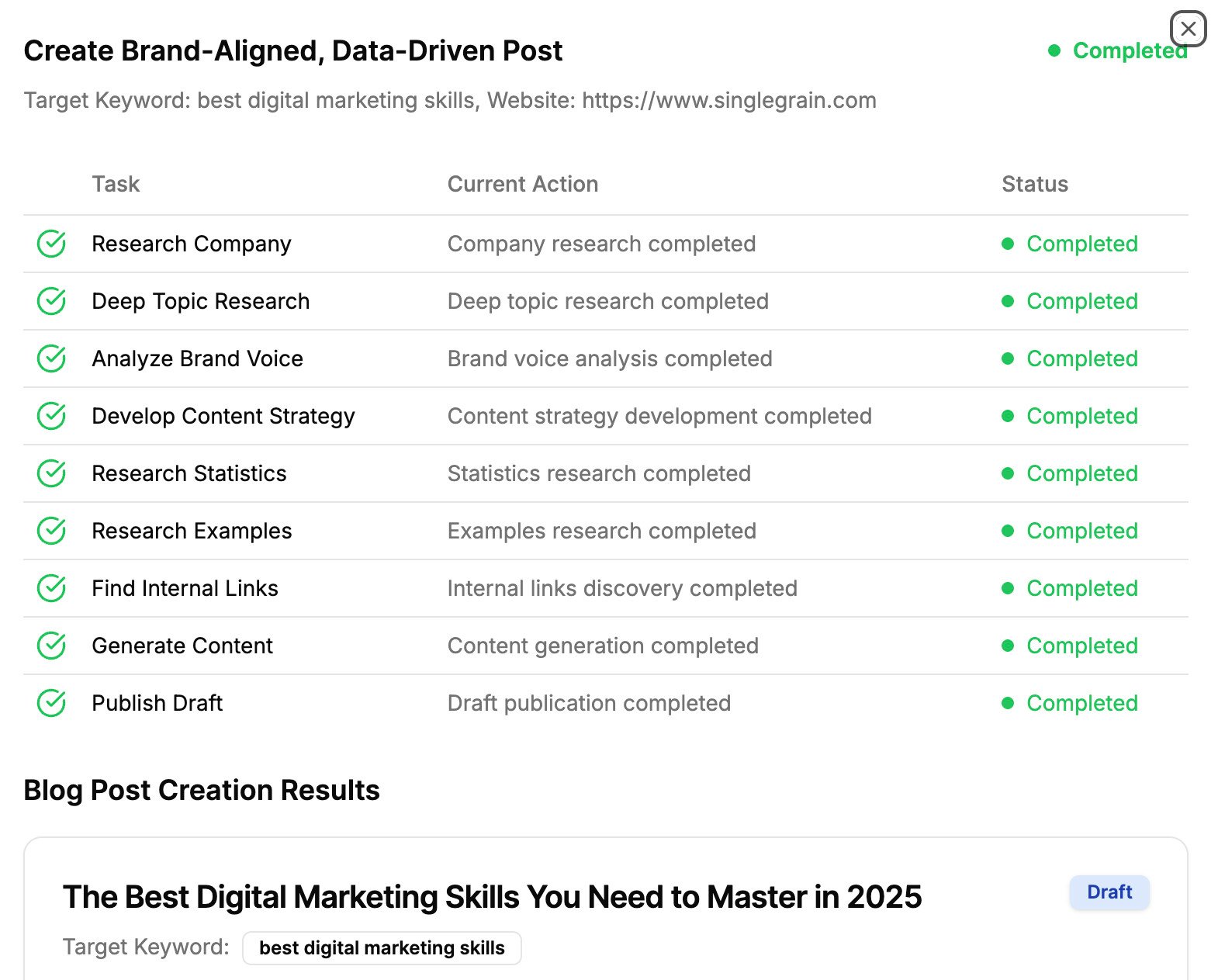If you’re looking for the optimal tactics to fuel your account based marketing strategy, this is the article for you.
We’ve been honing in on ABM strategies here at Single Grain, and we have a few power plays you ought to try out.
We’ve assembled ten core areas you’ll want to consider to ensure your ABM campaign is successful right out of the gate. Here are the account-based marketing best practices and strategies to attract specific customers in your prospect pool.
Key Highlights on Account-Based Marketing Best Practices
- To profit from your ABM marketing efforts, all marketers must implement different best practices.
- Identify target accounts likelier to convert and create personas (ICPs) to visualize your ideal customer.
- Since ABM hyper focuses on specific accounts, the ABM sales pipeline looks more like a pyramid, starting small by targeting specific accounts and growing toward the bottom.
- There are three types of ABM: strategic, ABM lite, and programmatic. Before beginning your campaign, plan which strategy to use.
- Your marketing and sales teams should collaborate on your campaign and work toward the same goals.
- Offer personalized content to prove you understand your account’s needs and goals.
- Use the right marketing and sales channels your accounts already use to boost visibility.
- Invest in ABM tools to streamline this process.
- ABM may require trial and error to achieve results, so measure several KPIs across all sales pipeline stages.
- ABM is only successful if you have long-lasting relationships with your accounts, so continue keeping them engaged to maximize revenue.
- Scale your ABM campaign by tiering account segments and using content and sales templates.
And with those covered, let’s cover each in more depth.
TABLE OF CONTENTS:
1. Identify and Prioritize Target Accounts
The secret to an effective ABM campaign is targeting the highest-quality accounts. But before doing so, you must identify the right accounts to move down the sales funnel and become customers.
How do you identify the best accounts to target? Start by leveraging data and collecting insights on accounts that have already converted. Use tools like your CRM or those who follow you on LinkedIn to collect this information.
Once you have this data, create an ideal customer profile (ICP). Your ICP should include firmographics such as company, industry, size, revenue, location, and anything you can gauge about buying behavior. It should also include the team members you’ll contact and their roles in the organization.
In the next section, we’ll define the three types of ABM, which vary by the number of accounts you’re targeting. If you plan on targeting a large group of accounts, segmenting them into various categories will help you stay organized while offering personalized content. You can categorize these groups based on firmographics or their likelihood of conversion.
2. Use the ABM Sales Pyramid
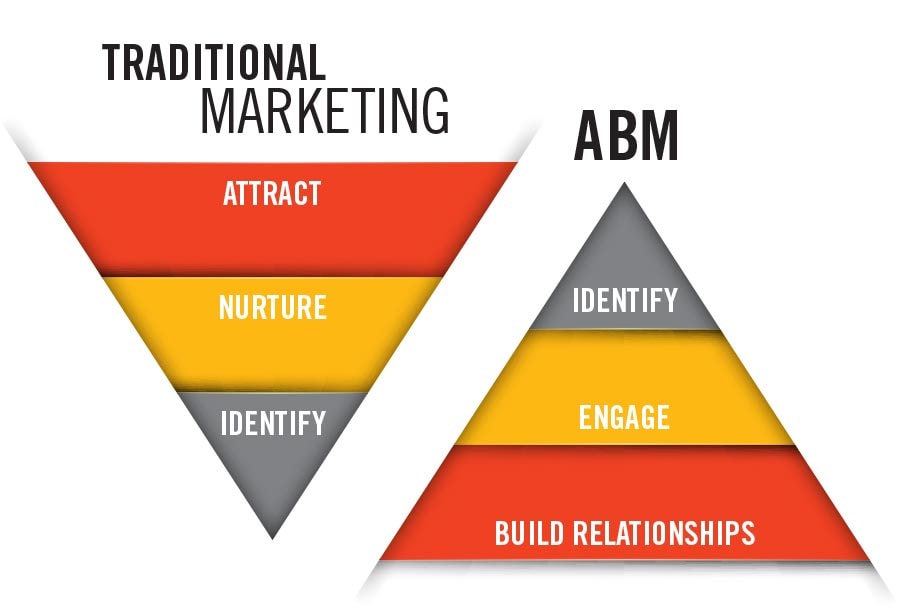
Source: MindFire Communications
The ABM sales process differs from traditional marketing tactics, and the sales funnel proves it. Conventional marketing strategies involve casting a wide net to attract several leads. ABM targets a small number of high-value accounts, so the account-based marketing sales pipeline is flipped and is more similar to a pyramid than a funnel.
The funnel starts small at the top since the first stage is identifying prospects. After marketers create ICPs, they immediately begin engaging and nurturing these accounts. That’s why conversion is stage three rather than the final stage. ABM’s goal is to create long-lasting customer relationships, so the final stage is building those connections and retaining accounts.
If you’re looking for help from an agency in scaling your ABM strategy, connect with our team at Single Grain. We’ve helped brands turn simple LinkedIn posts into some of the biggest needle movers for generating specific enterprise-level leads.
3. Know the Type of ABM You’ll Be Using
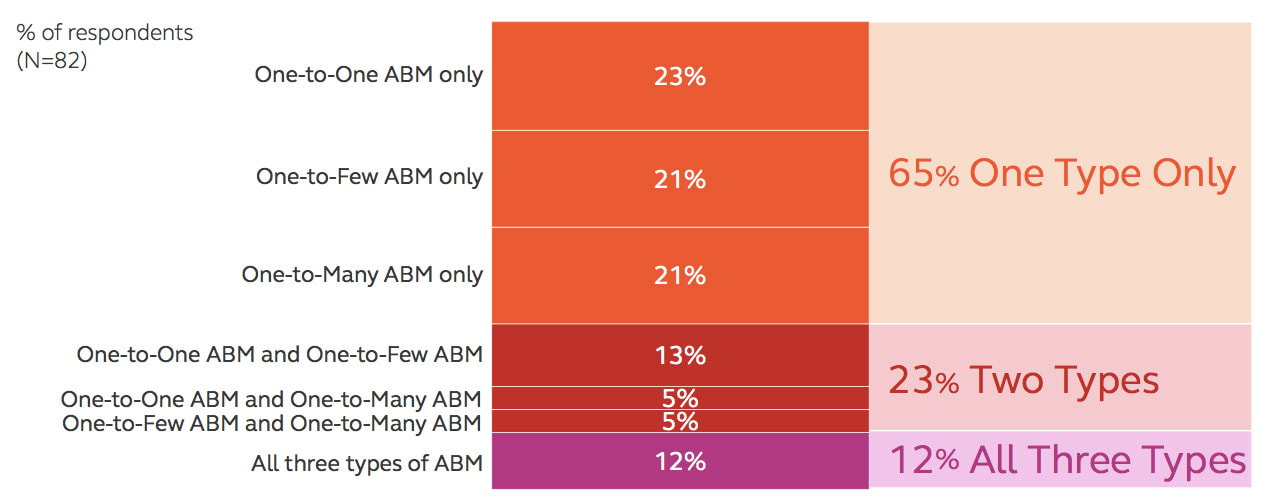
Source: LinkedIn
There are three types of ABM:
- Strategic ABM (one-to-one): Strengthening relationships with a select group of accounts to retain them. It can include strategies such as cross-selling and upselling.
- ABM lite (one-to-few): Targeting a few accounts with various similarities, such as their needs, goals, and challenges. A flexible strategy that’s not as focused as strategic ABM but still requires targeted messaging.
- Programmatic ABM (one-to-many): Attracting a larger net of accounts with commonalities, such as firmographics and demographics. It can include hundreds or thousands of target accounts, so grouping them is integral to delivering targeted messaging.
When planning your ABM campaign, know which type you’ll use and invest in the best tools and platforms before working on your strategy.
4. Align Sales and Marketing Teams
ABM combines marketing and sales initiatives to attract and convert accounts. That’s why your sales and marketing teams must collaborate on your campaign and work toward the same goals.
These teams must work together to:
- Agree on target account lists and personas.
- Segment prospects.
- Share data and insights.
- Create ABM tactics.
- Personalized messaging and content.
- Regularly communicate progress and adapt strategies.
Your organization can ease the collaboration process in many ways. For example, invest in tools so all teams can share information, work on the same documents, craft messaging, and stay engaged on the same channels.
5. Develop Personalized and Relevant Content for Each Account
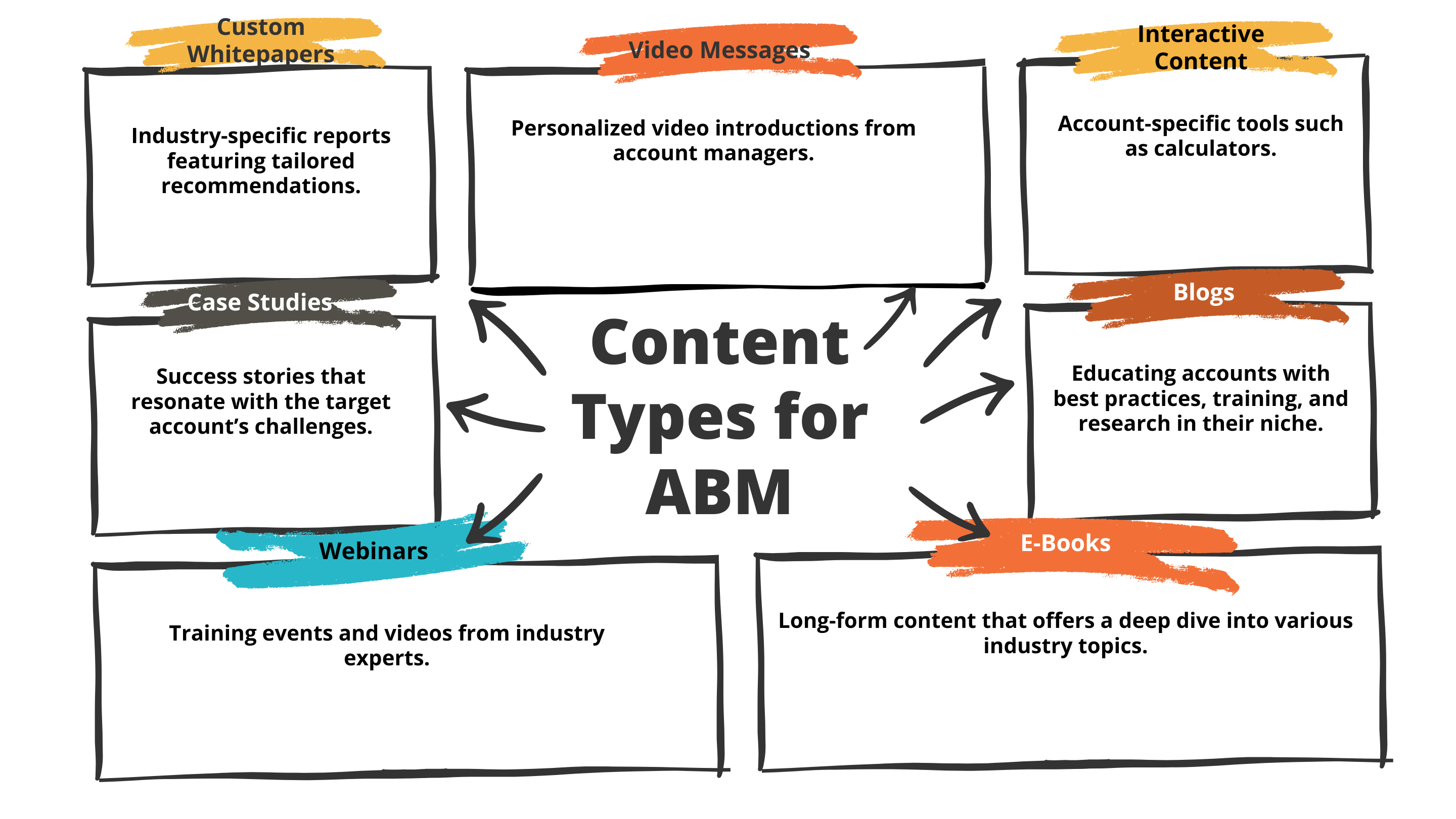
ABM thrives on delivering tailored experiences to capture attention. Create personalized content that your accounts care about and addresses their needs, pain points, and goals. Content examples include:
- Custom whitepapers: Industry-specific reports featuring tailored recommendations.
- Video messages: Personalized video introductions from account managers.
- Interactive content: Account-specific tools such as calculators.
- Case studies: Success stories that resonate with the target account’s challenges.
- Blogs: Educating accounts with best practices, training, and research in their niche.
- Webinars: Training events and videos from industry experts.
- E-books: Long-form content that offers a deep dive into various industry topics.
Marketers shouldn’t only care about the type of content they offer but also the topics that your accounts will want to consume. Start by understanding their needs and pain points. Avoid generalized and evergreen topics; get into the specifics of their industry, answer their questions, and cover the trends that are occurring.
Quality over quantity is also integral when creating ABM content. While marketers should aim to post a specific amount of content with a traditional strategy, ABM requires personalized messaging when needed.
6. Identify and Use the Right Channels
The only way you can introduce your brand to these accounts is if you have a presence where they hang out. Engaging your target accounts through multiple channels increases your visibility, but it’s always important to post on the platforms they’re already using. Your prospects are busy, so don’t make them look far and wide to find the solutions they need.
What are some examples of these channels? The most popular ones in the B2B space include:
- Email: Personalized email newsletters with value-driven messaging.
- Social media: LinkedIn and Twitter are particularly effective for B2B. (hint: there’s this nifty tool called Karrot, which can help speed up ABM ad creation like nothing you’ve ever seen before).
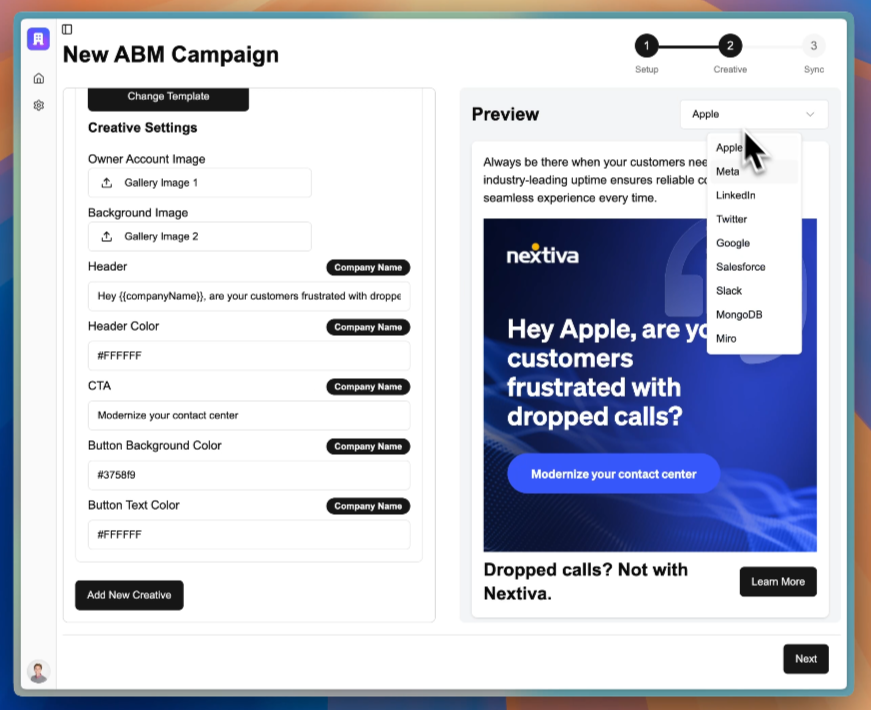
- Display ads: Use retargeting and programmatic ads.
- Direct mail and gifts: High-value accounts may appreciate thoughtful, tangible items.
- Events: Invite key accounts to webinars, workshops, or networking events.
Consistency across these touchpoints ensures a cohesive brand message.
7. Invest in Account-Based Marketing Tools
ABM can be tedious, so investing in the best resources can streamline this process.
Consider investing in tools like:
- Account identification: ZoomInfo or Demandbase
- Data enrichment: Cognism
- CRM: Salesforce
- Sales tools: LinkedIn Sales Navigator
- Marketing automation: ActiveCampaign
- Personalization: HubSpot or Marketo
- Analytics and attribution: Google Analytics or Tableau
8. Measure and Report Results
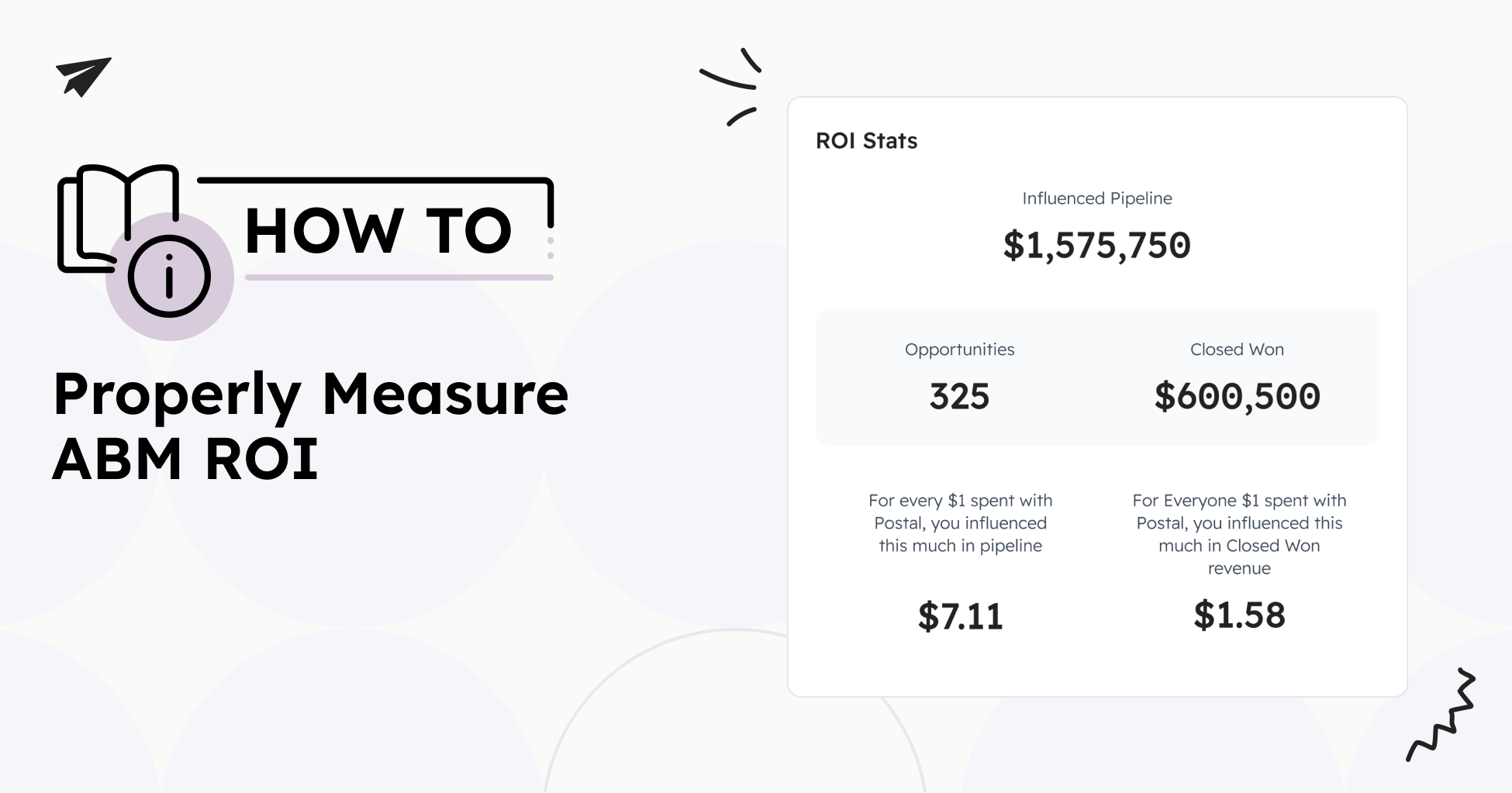
Source: Postal
If this is your first time working on an ABM strategy, achieving your ROI may take time. That’s why it’s important to measure specific KPIs and improve your strategy when necessary.
Key metrics to track include:
- Engagement: Time spent on content, email click-through rates, and ad impressions.
- Pipeline contribution: Number of new opportunities created and their deal value.
- Revenue: Total closed-won deals influenced by the campaign.
- Customer retention: Churn rate and upsell opportunities.
Measuring results at every sales funnel stage is also a good idea. While you can track general pipeline metrics, such as sales cycle length, tracking metrics in each stage will show how your accounts are moving through the funnel. Here are some examples:
- First stage – Identify: Target account awareness
- Second stage – Engage: Pipeline velocity
- Third stage – Convert: Conversion rate
- Fourth stage – Long-term relationships: Customer lifetime value
Use these insights to create comprehensive reports that showcase the value of your ABM efforts. If you’re changing anything in your strategy, such as trying new tactics, include this in your report.
9. Focus on Relationship Building
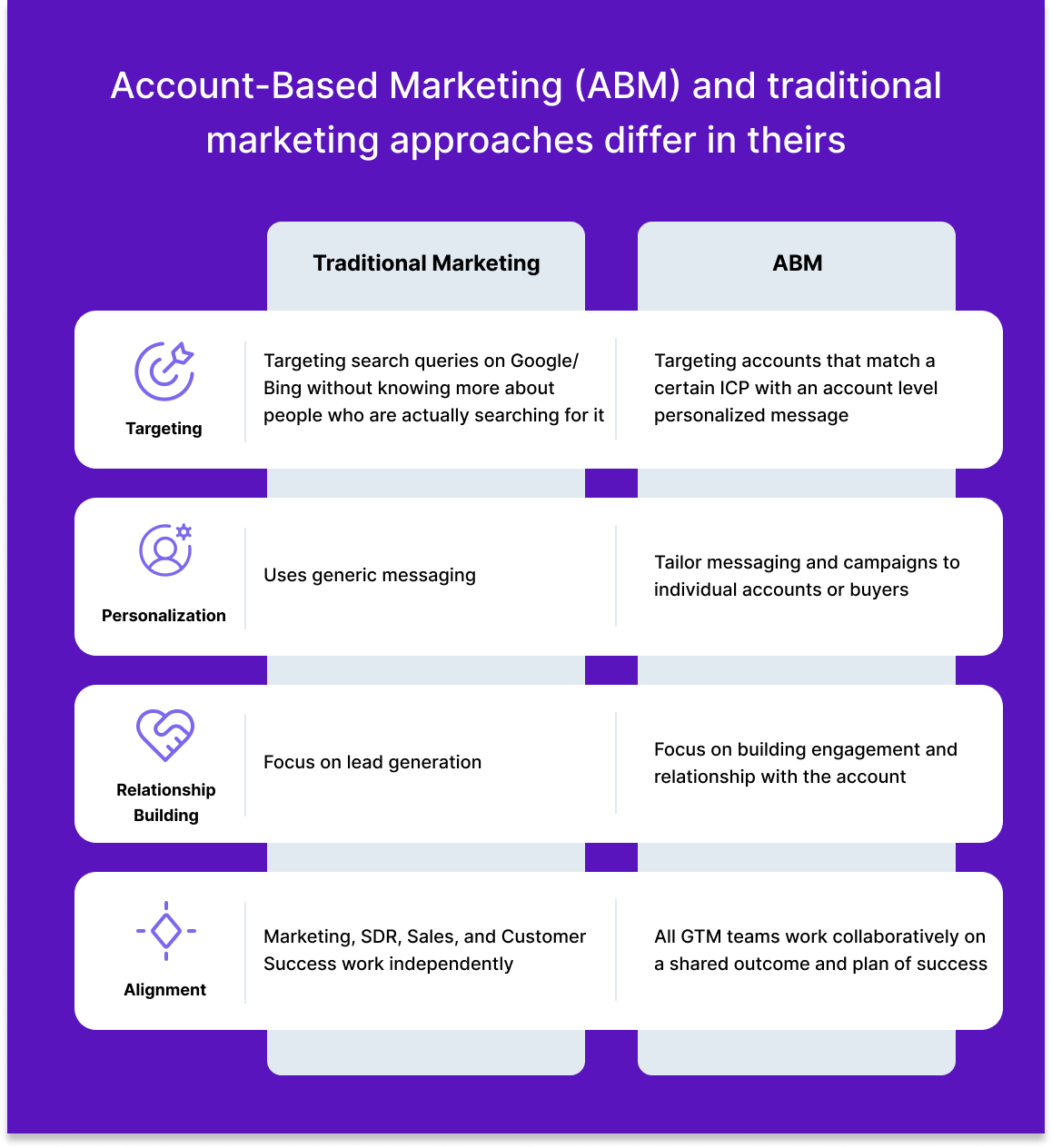
Source: Boomerang
ABM is not just about conversions—it’s about building long-term relationships with your high-value customers. Marketing and sales can still collaborate on account management by:
- Offering exceptional post-sale support.
- Sending regular updates on industry trends and insights.
- Inviting clients to exclusive events or advisory boards.
- Creating nurturing content such as onboarding guides and follow-up emails.
Happy customers become brand advocates, amplifying your efforts and contributing to sustained revenue growth.
10. Stay Scalable
As you refine your ABM strategy, consider how to scale your efforts without compromising personalization. This can be achieved through:
- Tiered approaches: Prioritize top-tier accounts for high-touch tactics while automating outreach for lower tiers.
- Content libraries: Build reusable templates and resources for common pain points.
- AI and automation: Use machine learning to identify patterns and predict behavior.
Scaling effectively allows you to expand your impact while maintaining efficiency.
Improve Your ROI With These Account-Based Marketing Best Practices
Instead of attracting many leads to build visibility, account-based marketing targets a small number of high-value accounts to drive revenue and maximize ROI. To have an effective ABM campaign, you need to implement account-based marketing best practices.
These best practices include aligning teams, personalizing content, leveraging technology, and focusing on relationships. As a result, you’ll create a campaign that drives meaningful results and builds long-lasting relationships.
If you’re ready to level up your account-based marketing strategy, Single Grain’s ABM experts can help!👇
Frequently Asked Questions About Account Based Marketing Best Practices
-
What are the principles of account-based marketing?
ABM is a B2B marketing technique that aligns sales and marketing to engage a specific set of high-quality leads.
Sales and marketing tactics are tailored to each account or segment, and marketers personalize all outreach to them. B2B marketers can use multiple channels to reach decision-makers and ABM technology to streamline their efforts. After these accounts convert to customers, marketers should establish long-term relationships with them.
-
How does ABM work?
ABM targets high-value accounts rather than a larger group of leads. Here are the main factors of an ABM strategy:
- Multichannel approach
- Sales and marketing alignment
- ABM software
Other factors driving ABM’s success include a hyper-personalized marketing strategy, sales pipeline-driven metrics, and long-term customer relationships.
-
Is ABM right for me?
While all B2B organizations will benefit from ABM, this largely depends on your marketing objectives. ABM will work for you if you have a high-value contracts, a long sales cycle, you’re willing to align your sales and marketing teams, you can invest in ABM tools, you already collect customer data, and you want to build long-term relationships with your customers.
-
What are the best ABM strategies?
Below are some proven ABM strategies to maximize success:
- Use tools to track buying signals and identify prospects who are actively researching your solutions.
- Nurture accounts with tailored content that addresses objections and accelerates decisions.
- Regularly communicate with accounts throughout the sales process.
- Leverage tools to automatically customize emails, ads, and website experiences for specific accounts.
- Send tailored emails based on role, challenges, and account stage in the buyer’s journey.
- Use one-to-one video messages or personalized phone calls to establish trust.
- Use machine learning to predict buying behavior and recommend next steps.
- Provide proactive support and resources to ensure clients achieve their goals.
- Continuously refine messaging, offers, and outreach strategies to improve results.
-
Which type of ABM will work for me?
When choosing the type of ABM to invest in, consider the number of accounts you want to target and how you plan to target them. Strategic ABM is the best strategy for businesses that want to attract a small number of accounts and host hyper-personalized campaigns. Businesses attracting groups of accounts with similar traits and hosting semi-personalized campaigns should choose ABM lite.
But if you’re targeting many accounts and need efficiency with your outreach, you should use programmatic ABM.
Related Video
For more insights and lessons about marketing, check out our Marketing School podcast on YouTube.






